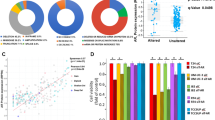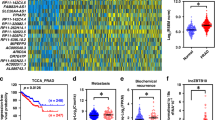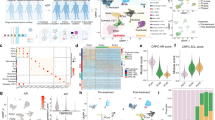Summary
Advanced prostate cancer is treated by androgen ablation and/or androgen receptor (AR) antagonists. In order to investigate the mechanisms relevant to the development of therapy-resistant tumours, we established a new tumour model which closely resembles the situation in patients who receive androgen ablation therapy. Androgen-sensitive LNCaP cells were kept in androgen-depleted medium for 87 passages. The new LNCaP cell subline established in this manner, LNCaP-abl, displayed a hypersensitive biphasic proliferative response to androgen until passage 75. Maximal proliferation of LNCaP-abl cells was achieved at 0.001 nM of the synthetic androgen methyltrienolone (R1881), whereas 0.01 nM of this compound induced the same effect in parental cells. At later passages (> 75), androgen exerted an inhibitory effect on growth of LNCaP-abl cells. The non-steroidal anti-androgen bicalutamide stimulated proliferation of LNCaP-abl cells. AR protein expression in LNCaP-abl cells increased approximately fourfold. The basal AR transcriptional activity was 30-fold higher in LNCaP-abl than in LNCaP cells. R1881 stimulated reporter gene activity in LNCaP-abl cells even at 0.01 nM, whereas 0.1 nM of R1881 was needed for induction of the same level of reporter gene activity in LNCaP cells. Bicalutamide that acts as a pure antagonist in parental LNCaP cells showed agonistic effects on AR transactivation activity in LNCaP-abl cells and was not able to block the effects of androgen in these cells. The non-steroidal AR blocker hydroxyflutamide exerted stimulatory effects on AR activity in both LNCaP and LNCaP-abl cells; however, the induction of reporter gene activity by hydroxyflutamide was 2.4- to 4-fold higher in the LNCaP-abl subline. The changes in AR activity were associated neither with a new alteration in AR cDNA sequence nor with amplification of the AR gene. Growth of LNCaP-abl xenografts in nude mice was stimulated by bicalutamide and repressed by testosterone. In conclusion, our results show for the first time that the non-steroidal anti-androgen bicalutamide acquires agonistic properties during long-term androgen ablation. These findings may have repercussions on the natural course of prostate cancer with androgen deprivation and on strategies of therapeutic intervention.
Similar content being viewed by others
Article PDF
Change history
16 November 2011
This paper was modified 12 months after initial publication to switch to Creative Commons licence terms, as noted at publication
References
Cher, ML, Bova, GS, Moore, DH, Small, EJ, Carroll, PR, Pin, SS, Epstein, JI, Isaacs, WB & Jensen, RH (1996). Genetic alterations in untreated metastases and androgen-independent prostate cancer detected by comparative genomic hybridization and allelotyping. Cancer Res 56: 3091–3102.
Culig, Z, Hobisch, A, Cronauer, MV, Cato, ACB, Hittmair, A, Radmayr, C, Eberle, J, Bartsch, G & Klocker, H (1993a). Mutant androgen receptor detected in an advanced-stage prostatic carcinoma is activated by adrenal androgens and progesterone. Mol Endocrinol 7: 1541–1550.
Culig, Z, Klocker, H, Eberle, J, Kaspar, F, Hobisch, A, Cronauer, MV & Bartsch, G (1993b). DNA sequence of the androgen receptor in prostatic tumor cell lines and tissue specimens assessed by means of the polymerase chain reaction. Prostate 22: 11–22.
Culig, Z, Hobisch, A, Cronauer, MV, Radmayr, C, Trapman, J, Hittmair, A, Bartsch, G & Klocker, H (1994). Androgen receptor activation in prostatic tumor cell lines by insulin-like growth factor-I, keratinocyte growth factor, and epidermal growth factor. Cancer Res 54: 5474–5478.
Cronauer, MV, Klocker, H, Talasz, H, Geisen, FH, Hobisch, A, Radmayr, C, Böck, G, Culig, Z, Schirmer, M, Reissigl, A, Bartsch, G & Konwalinka, G (1996). Inhibitory effects of the nucleoside analogue gemcitabine on prostatic carcinoma cells. Prostate 28: 172–181.
Culig, Z, Hobisch, A, Hittmair, A, Cronauer, MV, Radmayr, C, Zhang, J, Bartsch, G & Klocker, H (1997a). Synergistic activation of androgen receptor by androgen and luteinizing hormone-releasing hormone in prostatic carcinoma cells. Prostate 32: 106–114.
Culig, Z, Hobisch, A, Hittmair, A, Cronauer, MV, Radmayr, C, Bartsch, G & Klocker, H (1997b). Androgen receptor gene mutations in prostate cancer. Implications for disease progression and therapy. Drugs Aging 10: 50–58.
Dijkman, GA & Debruyne, FM (1996). Epidemiology of prostate cancer. Eur Urol 30: 281–295.
Froesch, BA, Takayama, S & Reed, JC (1998). BAG-1L protein enhances androgen receptor function. J Biol Chem 273: 11660–11666.
Gibas, Z, Becher, R, Kawinski, E, Horoszewicz, J & Sandberg, AA (1984). A high-resolution study of chromosome changes in a human prostate carcinoma cell line. Cancer Genet Cytogenet 11: 399–404.
Gupta, C, Chandorkar, A & Nguyen, AP (1996). Activation of androgen receptor in epidermal growth factor modulation of fetal mouse sexual differentiation. Mol Cell Endocrinol 123: 89–95.
Hobisch, A, Culig, Z, Radmayr, C, Bartsch, G, Klocker, H & Hittmair, A (1995). Distant metastases from prostatic carcinoma express androgen receptor protein. Cancer Res 55: 3068–3072.
Hobisch, A, Culig, Z, Radmayr, C, Bartsch, G, Klocker, H & Hittmair, A (1996). Androgen receptor status of lymph node metastases from prostate cancer. Prostate 28: 129–135.
Horoszewicz, JS, Leong, SS, Kawinski, E, Karr, JP, Rosenthal, H, Chu, TM, Mirand, EA & Murphy, GP (1983). LNCaP model of human prostatic carcinoma. Cancer Res 43: 1809–1818.
Hyytinen, ER, Thalmann, GN, Zhau, HE, Karhu, R, Kallioniemi, OP, Chung, LWK & Visakorpi, T (1997). Genetic changes associated with the acquisition of androgen-independent growth, tumorigenicity and metastatic potential in a prostate cancer model. Br J Cancer 75: 190–195.
Ikonen, T, Palvimo, JJ & Jänne, OA (1997). Interaction between the amino- and carboxyl-terminal regions of the rat androgen receptor modulates transcriptional activity and is influenced by nuclear receptor coactivators. J Biol Chem 272: 29821–29828.
Jeng, M-H, Shupnik, MA, Bender, TP, Westin, EH, Bandyopadhyay, D, Kumar, R, Masamura, RJ & Santen, RJ (1998). Estrogen receptor expression and function in longterm estrogen-deprived human breast cancer cells. Endocrinology 139: 4164–4174.
Kaighn, ME, Shankar Narayan, K, Ohnuki, Y, Lechner, JF & Jones, LW (1979). Establishment and characterization of a human prostatic carcinoma cell line (PC-3). Invest Urol 17: 16–23.
Kallioniemi, OP, Kallioniemi, A, Piper, J, Isola, J, Waldman, FM, Gray, JW & Pinkel, D (1994). Optimizing comparative genomic hybridization for analysis of DNA sequence copy number changes in solid tumors. Genes Chromosomes Cancer 10: 231–243.
Kirschenbaum, A, Ren, M & Levine, AC (1993). Enhanced androgen sensitivity in serum-free medium of a subline of the LNCaP human prostate cancer cell line. Steroids 58: 439–444.
Koivisto, P, Kononen, J, Palmberg, C, Tammela, T, Hyytinen, E, Isola, J, Trapman, J, Cleutjens, K, Noordzij, A, Visakorpi, T & Kallioniemi, OP (1997). Androgen receptor gene amplification: a possible molecular mechanism for androgen deprivation therapy failure in prostate cancer. Cancer Res 57: 314–319.
Kokontis, J, Takakura, K, Hay, N & Liao, S (1994). Increased androgen receptor activity and altered c-myc expression in prostate cancer cells after long-term androgen deprivation. Cancer Res 54: 1566–1573.
Kokontis, JM, Hay, N & Liao, S (1998). Progression of LNCaP prostate tumor cells during androgen deprivation: hormone-independent growth, repression of proliferation by androgen, and role for p27Kip 1 in androgen-induced cell cycle arrest. Mol Endocrinol 12: 941–953.
Konig, JJ, Kamst, E, Hagemeijer, A, Romijn, JC, Horoszewicz, J & Schröder, FH (1989). Cytogenetic characterization of several androgen responsive and unresponsive sublines of the human prostatic carcinoma cell line LNCaP. Urol Res 17: 79–86.
Langer, PR, Waldrop, AA & Ward, DC (1981). Enzymatic synthesis of biotin-labeled polynucleotides: novel nucleic acid affinity probes. Proc Natl Acad Sci USA 78: 6633–6637.
Lee, C, Sutkowski, DM, Sensibar, JA, Zelner, D, Kim, I, Amsel, I, Shaw, N, Prins, GS & Kozlowski, JM (1995). Regulation of proliferation and production of prostate-specific antigen in androgen-sensitive prostatic cancer cells, LNCaP, by dihydrotestosterone. Endocrinology 136: 796–805.
Miyamoto, H, Yeh, S, Wilding, G & Chang, C (1997). Promotion of agonist activity of antiandrogens by the androgen receptor coactivator, ARA70, in human prostate cancer DU145 cells. Proc Natl Acad Sci USA 95: 7379–7384.
Nakhla, AM, Romas, NA & Rosner, W (1997). Estradiol activates the prostate androgen receptor and prostate-specific antigen secretion through the intermediacy of sex hormone-binding globulin. J Biol Chem 272: 6838–6841.
Nazareth, LV & Weigel, NL (1996). Activation of the human androgen receptor through a protein kinase A signaling pathway. J Biol Chem 271: 19900–19907.
Romijn, JC, Verkoelen, CF & Schroeder, FH (1988). Application of the MTT assay to human prostate cancer cell lines in vitro: establishment of test conditions and assessment of hormone-stimulated growth and drug-induced cytostatic and cytotoxic effects. Prostate 12: 99–110.
Scher, HI & Kolvenbag, GJ (1997). The antiandrogen withdrawal syndrome in relapsed prostate cancer. Eur Urol 31: 3–7.
Schuurmans, ALG, Bolt, J, Voorhorst, M, Blankenstein, RA & Mulder, E (1988). Regulation of growth and epidermal growth factor receptor levels of LNCaP prostatic tumor cells by different steroids. Int J Cancer 42: 917–922.
Stone, KR, Mickey, DD, Wunderli, H, Mickey, GH & Paulson, DF (1978). Isolation of a human prostate carcinoma cell line (DU 145). Int J Cancer 21: 274–281.
Taplin, ME, Bubley, GJ, Shuster, TD, Frantz, ME, Spooner, AE, Ogata, GK, Keer, HN & Balk, SP (1995). Mutation of the androgen receptor gene in metastatic androgen-independent prostate cancer. New Engl J Med 332: 1393–1398.
Thomson, AA, Foster, BA & Cunha, GR (1997). Analysis of growth factor and receptor mRNA levels during development of the rat seminal vesicle and prostate. Development 124: 2431–2439.
Tilley, WD, Wilson, CM, Marcelli, M & McPhaul, MJ (1990). Androgen receptor gene expression in human prostate carcinoma cell lines. Cancer Res 50: 5382–5386.
Umekita, Y, Hiipakka, RA, Kokontis, JM & Liao, S (1996). Human prostate tumor growth in athymic mice: inhibition by androgens and stimulation by finasteride. Proc Natl Acad Sci USA 93: 15152–15157.
Van der Kwast, TH, Schalken, J, Ruizeveld de Winter, JA, van Vroonhoven, CCJ, Mulder, E, Boersma, W & Trapman, J (1991). Androgen receptors in endocrine-therapy-resistant human prostate cancer. Int J Cancer 48: 189–193.
Veldscholte, J, Ris-Stalpers, C, Kuiper, GGJM, Jenster, G, Berrevoets, C, Claassen, E, van Rooij, HCJ, Trapman, J & Brinkmann, AO (1990). A mutation in the ligand binding domain of the androgen receptor of human LNCaP cells affects steroid binding characteristics and response to anti-androgens. Biochem Biophys Res Commun 17: 534–540.
Veldscholte, J, Berrevoets, CA, Zegers, ND, van der Kwast, TH, Grootgoed, JA & Mulder, E (1992). Hormone-induced dissociation of the androgen receptor-heat-shock protein complex: use of a new monoclonal antibody to distinguish transformed from nontransformed receptors. Biochemistry 31: 7422–7430.
Visakorpi, T, Hyytinen, E, Koivisto, P, Tanner, M, Keinänen, R, Palmberg, C, Palotie, A, Tammela, T, Isola, J & Kallioniemi, OP (1995). In vivo amplification of the androgen receptor gene and progression of human prostate cancer. Nature Gen 9: 401–406.
Voegel, JJ, Heine, MJ, Zechel, C, Chambon, P & Gronemeyer, H (1996). TIF2, a 160 kDa transcriptional mediator for the ligand-dependent activation function AF-2 of nuclear receptors. EMBO J 15: 3667–3675.
Wilding, G, Chen, M & Gelmann, EP (1989). Aberrant response in vitro of hormone-responsive prostate cancer cells to antiandrogens. Prostate 14: 103–115.
Yeh, S & Chang, C (1996). Cloning and characterization of a specific coactivator, ARA70, for the androgen receptor in human prostate. Proc Natl Acad Sci USA 93: 5517–5521.
Author information
Authors and Affiliations
Rights and permissions
From twelve months after its original publication, this work is licensed under the Creative Commons Attribution-NonCommercial-Share Alike 3.0 Unported License. To view a copy of this license, visit http://creativecommons.org/licenses/by-nc-sa/3.0/
About this article
Cite this article
Culig, Z., Hoffmann, J., Erdel, M. et al. Switch from antagonist to agonist of the androgen receptor blocker bicalutamide is associated with prostate tumour progression in a new model system. Br J Cancer 81, 242–251 (1999). https://doi.org/10.1038/sj.bjc.6690684
Received:
Revised:
Accepted:
Published:
Issue date:
DOI: https://doi.org/10.1038/sj.bjc.6690684
Keywords
This article is cited by
-
Glucocorticoid treatment influences prostate cancer cell growth and the tumor microenvironment via altered glucocorticoid receptor signaling in prostate fibroblasts
Oncogene (2024)
-
Effectiveness and durability of benefit of mTOR inhibitors in a real-world cohort of patients with metastatic prostate cancer and PI3K pathway alterations
Prostate Cancer and Prostatic Diseases (2023)
-
Identification of PIM1 substrates reveals a role for NDRG1 phosphorylation in prostate cancer cellular migration and invasion
Communications Biology (2021)
-
Apalutamide radio-sensitisation of prostate cancer
British Journal of Cancer (2021)
-
Transcription recycling assays identify PAF1 as a driver for RNA Pol II recycling
Nature Communications (2021)



